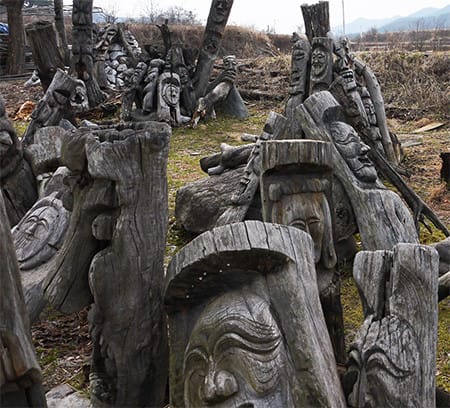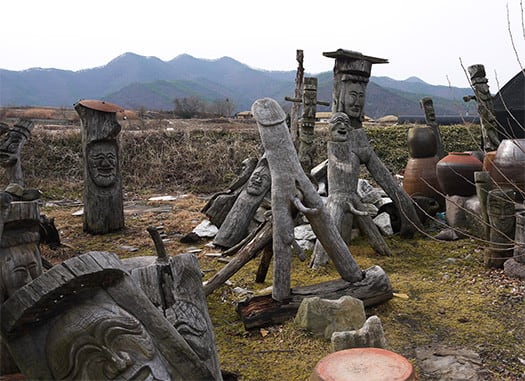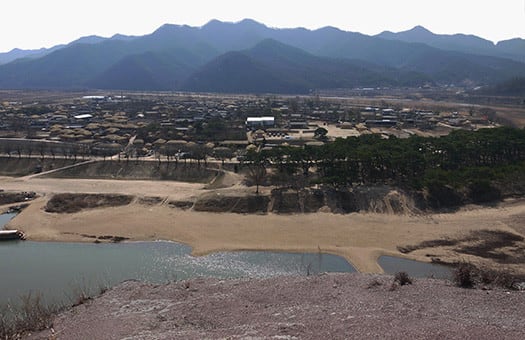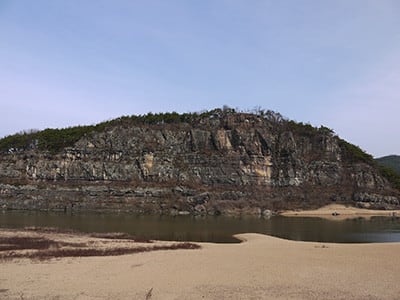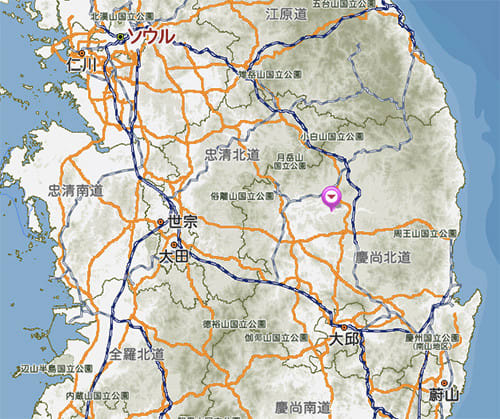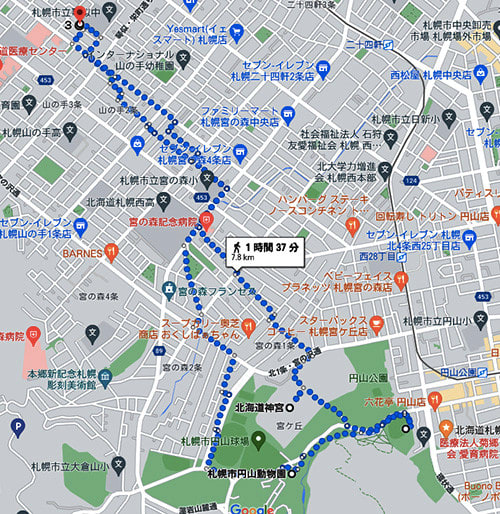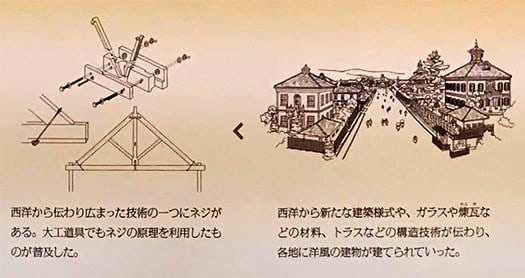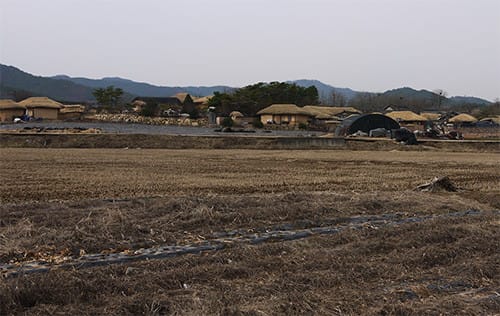
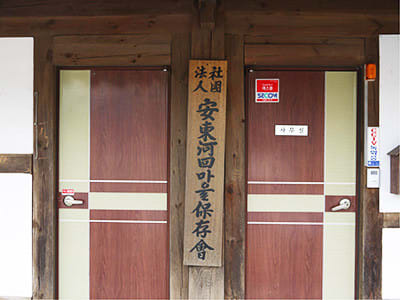
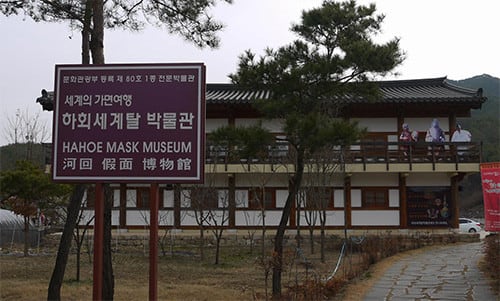
弊社には韓国人スタッフが勤務してくれています。
それも「編集」スタッフとして先頭に立って活躍してくれています。
日本語のプロとしての仕事をこなしてくれているのです。
日韓で逆のことを考えたら、そのバイリンガルぶりに驚かされます。
半島社会というのはこういう柔軟性を育むものなのかと。
かれが入社してくれたので、顧客先の建築会社の方から
「せっかく札幌で就職してくれたしガイド役も頼めるし(笑)」みたいな展開で
この韓国ツアーは実現した次第です。
ただ、こちら側ではあんまり知識がなかったので見学先もかれに依存した。
このハフェマウルを推奨してくれたのには感謝しております。
さて、この河回村(ハフェマウル)見学に至って韓国の田舎風景に接した。
その民族がどんな土地利用をしてなにを食べているかは基本的理解ポイント。
なにげに建築集落に至るまでの風景を目にしたのですがコメっぽい。
でも日本で一般的な水田風景とはちょっと違いが感じられる。
訪問時には印象として「なんか違うなぁ」程度でしたが、
どうも水田栽培というより陸稲栽培に印象が近い。あぜ道が見えない。
ちょっと調べてみると(国士舘大学・原田信男先生著述より)
〜朝鮮半島でも盛んに稲作が行われてきましたが日本のように、
特に米の価値観に国家や人々の視線が集中することはありませんでした。
朝鮮では日本に比べて稲作技術の展開が遅れました。19世紀末ごろの
朝鮮における苗代の種まき量は同時期の日本の倍近いもので、
稲作の生産量がかなり低かったことになります。
これは朝鮮では用排水路が整備されていないため天水田が8割を占めており、
単位面積当たりの収量が少なかったためです。
日本統治時代の1920年代から朝鮮総督府は産米増殖計画を打ち出し、
耕種の改善と80万ha相当の土地改良を行うとしました。その結果、
1910年には190万トンだった収量が1940年には400万トンに増加しました。〜
コメの栽培が日本にどう伝播してきたかはいまも盛んに研究されている。
なかなか結論の出るテーマではないようです。一方で近代に至って
韓国ではこういう状況から日本へ輸出できる状況にまでなったようです。
逆に言うと、日本は高温多雨気候であり水田栽培とその水利管理に
強い情熱を傾けてきた社会・民族だということが理解出来る。
韓国ではこの気候条件が違ったことで水源管理・土木改良への
強いこだわりを持つことがより少なかったという事情が浮かんでくる。
さらに調べていて、韓国では「赤米」品種が多かった事実もわかった。
で、赤米というのはインドからの伝播品種ということで
きのう触れた土俗的海民型文化の残滓とも符合するかと思われました。
いずれにしても興味深い社会文化の対比だと思います。
さらに漢字文化ですが、建物の表札を見てその近似と相違を思わされる。
上の「社団法人・・・」という表札は漢字とハングルの混淆のようですが、
社団法人という語彙は日本とまったく同様なので、
このあたりも調べてみたくなるテーマだと思いました。
こういった混淆は日本的な「かな」活用と近似も感じさせられる。
・・・近い国なので文化の近似と相違がさまざまな歴史交流を
かなり具体的に知らせてくれてテーマがどんどん沸き立ってくる。
欧米に行くのとはまったく違う体験をもたらせてくれますね。
English version⬇
[Recollection of "Hahoe Village", which is different from the approximation of rice production and kanji between Japan and Korea-3]
Korean staff are working at our company.
It is also leading the way as an "editing" staff member.
He is doing his job as a Japanese professional.
When I think about the opposite in Japan and Korea, I am surprised at how bilingual it is.
I wonder if peninsula society fosters this kind of flexibility.
He joined the company, so from the construction company of the customer
With a development like "I got a job in Sapporo and I can ask for a guide role (laugh)"
This Korean tour has come true.
However, I didn't have much knowledge on this side, so I depended on him for the tour.
Thank you for recommending this Hafemaul.
By the way, I came into contact with the countryside of Korea when I visited Hahoe Village.
The basic understanding is what kind of land the people are using and what they are eating.
I saw the scenery leading up to the architectural village, but it looks like rice.
However, I feel a little different from the rice field scenery that is common in Japan.
At the time of the visit, the impression was that it was something different,
The impression is closer to upland rice cultivation than paddy cultivation. I can't see the road.
A little research (from the writing by Professor Nobuo Harada of Kokushikan University)
~ Rice cultivation has been actively carried out on the Korean Peninsula, but like Japan,
In particular, the eyes of the nation and people did not concentrate on the values of rice.
In Korea, the development of rice cultivation technology was delayed compared to Japan. Around the end of the 19th century
The amount of seedlings sowed in Korea is almost double that of Japan at the same time.
This means that rice production was quite low.
This is because rain-fed paddy fields occupy 80% because there is no drainage channel in Korea.
This is because the yield per unit area was low.
Since the 1920s during the Japanese colonial rule, the Government-General of Korea has launched a rice-producing breeding plan.
It was decided to improve cultivation and land improvement equivalent to 800,000 ha. resulting in,
The yield increased from 1.9 million tonnes in 1910 to 4 million tonnes in 1940. ~
How rice cultivation has spread to Japan is still being actively studied.
It doesn't seem to be a theme that can be easily concluded. On the other hand, in modern times
It seems that South Korea has changed from this situation to the situation where it can be exported to Japan.
Conversely, Japan has a hot and rainy climate, and for paddy field cultivation and its water use management.
It can be understood that it is a society / ethnic group that has a strong passion.
Due to the different climatic conditions in South Korea, water source management and civil engineering improvement
The situation emerges that it was less likely to have a strong commitment.
Further investigation revealed that there were many "red rice" varieties in South Korea.
So, red rice is a variety transmitted from India.
It seemed to match the remnants of the folk-style culture that I touched on yesterday.
In any case, I think it's an interesting contrast of social culture.
Furthermore, regarding the Chinese character culture, looking at the nameplate of the building, it seems that the approximation is different.
The nameplate "Incorporated association ..." above seems to be a mixture of Kanji and Hangul,
The vocabulary of corporate juridical person is exactly the same as in Japan,
I thought this was a theme that I would like to investigate.
This kind of chaos makes us feel that it is similar to the Japanese use of "kana".
・ ・ ・ Because it is a close country, there are various historical exchanges due to cultural approximations and differences.
The theme is getting more and more exciting as it informs me quite concretely.
It gives you a completely different experience than going to the West.












